Sony H3311, H3321, H4311, H4331 User Guide

User guide
Xperia L2
H3311/H3321/H4311/H4331
Contents |
|
Getting started.............................................................................. |
6 |
About this User guide....................................................................... |
6 |
Overview........................................................................................... |
7 |
Assembly – Single SIM...................................................................... |
8 |
Assembly – Dual SIM......................................................................... |
8 |
Screen protection.............................................................................. |
9 |
Starting your device for the first time.............................................. |
9 |
Why do I need a Google account?.................................................. |
10 |
Device security............................................................................. |
12 |
Making sure your device is protected............................................. |
12 |
Screen lock....................................................................................... |
12 |
Unlocking your device automatically.............................................. |
13 |
Fingerprint Manager........................................................................ |
13 |
SIM card protection......................................................................... |
14 |
Using multiple SIM cards................................................................. |
14 |
Finding the IMEI number(s) of your device..................................... |
15 |
Finding, locking or erasing a lost device ....................................... |
16 |
Using location services.................................................................... |
16 |
Learning the basics...................................................................... |
18 |
Using the touchscreen.................................................................... |
18 |
Turning the screen on or off........................................................... |
20 |
Smart backlight control.................................................................. |
20 |
Home screen................................................................................... |
20 |
Application screen.......................................................................... |
23 |
Navigating applications.................................................................. |
24 |
Widgets........................................................................................... |
26 |
Shortcuts and folders...................................................................... |
27 |
Background and themes................................................................ |
28 |
Taking a screenshot........................................................................ |
28 |
Notifications.................................................................................... |
28 |
Icons in the status bar..................................................................... |
31 |
Applications overview..................................................................... |
33 |
Battery and maintenance............................................................ |
35 |
Charging your device...................................................................... |
35 |
Battery and power management................................................... |
36 |
Updating your device...................................................................... |
38 |
Maintenance using a computer..................................................... |
39 |
Storage and memory...................................................................... |
40 |
Backing up and restoring content.................................................. |
42 |
2
Downloading applications.......................................................... |
45 |
Downloading applications from Google Play................................ |
45 |
Downloading applications from other sources.............................. |
45 |
Internet and networks................................................................ |
46 |
Browsing the web........................................................................... |
46 |
Internet and MMS settings ............................................................ |
46 |
Wi-Fi................................................................................................. |
47 |
Sharing your mobile data connection............................................ |
49 |
Controlling data usage................................................................... |
50 |
Selecting a SIM card for data traffic................................................ |
51 |
Selecting mobile networks............................................................. |
52 |
Synchronising data on your device............................................. |
53 |
Synchronising with online accounts............................................... |
53 |
Synchronising with Microsoft Exchange ActiveSync...................... |
53 |
Basic settings.............................................................................. |
55 |
Accessing settings.......................................................................... |
55 |
Volume, vibration and sound......................................................... |
55 |
Silence your device with Do not disturb........................................ |
56 |
Screen settings................................................................................ |
57 |
Screen pinning................................................................................ |
58 |
Application settings........................................................................ |
58 |
Resetting your applications............................................................ |
59 |
Language settings.......................................................................... |
60 |
Date and time................................................................................. |
60 |
Enhancing the sound output.......................................................... |
61 |
Multiple user accounts.................................................................... |
61 |
Typing text................................................................................... |
64 |
On-screen keyboards..................................................................... |
64 |
Editing text...................................................................................... |
65 |
Calling.......................................................................................... |
66 |
Making calls.................................................................................... |
66 |
Receiving calls................................................................................. |
67 |
Forwarding calls.............................................................................. |
68 |
Blocking a number.......................................................................... |
69 |
Contacts....................................................................................... |
70 |
Adding and editing contacts.......................................................... |
70 |
Transferring contacts....................................................................... |
71 |
Backing up contacts........................................................................ |
72 |
Messaging and chat.................................................................... |
73 |
Reading and sending messages.................................................... |
73 |
Messaging settings......................................................................... |
74 |
Video chat....................................................................................... |
75 |
3
Setting up email.............................................................................. |
75 |
Music and FM radio..................................................................... |
76 |
Transferring music to your device.................................................. |
76 |
Listening to music........................................................................... |
76 |
Listening to the radio...................................................................... |
78 |
Camera........................................................................................ |
80 |
Getting to know your camera........................................................ |
80 |
Exposure, colour and light conditions............................................ |
83 |
Setting the right focus.................................................................... |
86 |
People, selfies and smiling faces................................................... |
86 |
Moving objects................................................................................ |
87 |
Resolution and memory................................................................. |
87 |
Diagnosing your camera................................................................ |
89 |
Additional camera settings............................................................ |
89 |
Photos and videos in Album....................................................... |
91 |
Viewing photos and videos............................................................ |
91 |
Album home screen menu............................................................. |
92 |
Sharing and managing photos and videos.................................... |
93 |
Hiding photos and videos.............................................................. |
94 |
Connectivity................................................................................. |
95 |
Connecting your device to USB accessories.................................. |
95 |
NFC (Near Field Communication)................................................... |
95 |
Bluetooth wireless technology....................................................... |
97 |
Smart apps and features that save you time........................... |
100 |
Google Feed.................................................................................. |
100 |
Using your device as a wallet....................................................... |
100 |
Xperia Actions............................................................................... |
100 |
Clock and Calendar.................................................................... |
102 |
Calendar......................................................................................... |
102 |
Clock.............................................................................................. |
102 |
Accessibility............................................................................... |
105 |
Magnification................................................................................. |
105 |
Font size......................................................................................... |
105 |
Display size.................................................................................... |
105 |
Colour correction........................................................................... |
105 |
TalkBack......................................................................................... |
105 |
Mono audio................................................................................... |
106 |
Switch Access................................................................................ |
106 |
Support and legal...................................................................... |
107 |
Support application....................................................................... |
107 |
Restarting, resetting and repairing............................................... |
107 |
4
Warranty, SAR and usage guidelines............................................ |
108 |
Legal information.......................................................................... |
108 |
5

Getting started
About this User guide
This is the Xperia L2 User guide for the Android™ 7.1 software version. If you're not sure which software version your device is running, you can check it in the Settings menu.
System and application updates can present the features in your device in another way than described in this User guide. The Android™ version might not be affected in an update. For more information about software updates, see Updating your device on page 38.
To check the current software version and model number of your device
1Find and tap Settings > About phone.
2The current software version is displayed under Build number. The current model number is displayed under Model.
Limitations to services and features
Some of the services and features described in this User guide may not be supported in all countries or regions, or by all networks or service providers. The GSM International Emergency Number can always be used in all countries, regions, networks and by all service providers, provided that the device is connected to the mobile network. Please contact your network operator or service provider to determine the availability of any specific service or feature and whether additional access or usage fees apply.
The use of certain features and applications described in this guide may require access to the internet. You may incur data connection charges when you connect to the internet with your device. Contact your wireless service provider for more information.
6
This is an internet version of this publication. © Print only for private use.

Overview
7
This is an internet version of this publication. © Print only for private use.
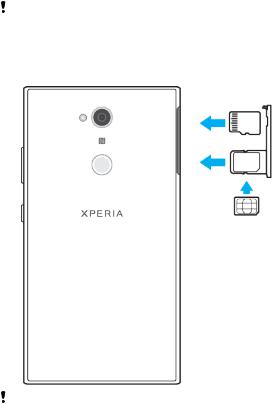
1. Charging/Notification light |
10. Main microphone |
2. Headset jack |
11. Charger/USB Type-C™ cable port |
3. Proximity sensor |
12. Wi-Fi/GPS/Bluetooth® antenna area |
4. Ear speaker |
13. Flash LED |
5. Front camera |
14. Main camera lens |
6. Secondary microphone |
15. NFC™ detection area |
7. Volume/Zoom key |
16. Nano SIM/Memory card slot |
8. Power key |
17. Fingerprint sensor |
9. Loudspeaker |
18. Main antenna area |
Assembly – Single SIM
Your device only supports nano SIM cards. Single SIM devices allow you to use one SIM card and a memory card.
The nano SIM card and the memory card have separate slots. Make sure you don’t confuse the two.
For information on how to check if your device is Single SIM or Dual SIM, see
Finding the IMEI number(s) of your device on page 15.
To prevent data loss, make sure you turn off your device or unmount the memory card before you drag out the holder to remove the nano SIM card or memory card from the device.
To insert a nano SIM card and a memory card
Do not cut your SIM card, as this may damage your device.
1Drag out the SIM card tray.
2Place the memory card in the correct orientation into the memory card slot, as shown in the illustration.
3Place the SIM card securely in the SIM card tray, as shown in the illustration.
4Gently push the tray back into the slot until it fits into place.
Assembly – Dual SIM
Your device only supports nano SIM cards. Dual SIM devices support the use of one or two nano SIM cards and a memory card.
8
This is an internet version of this publication. © Print only for private use.
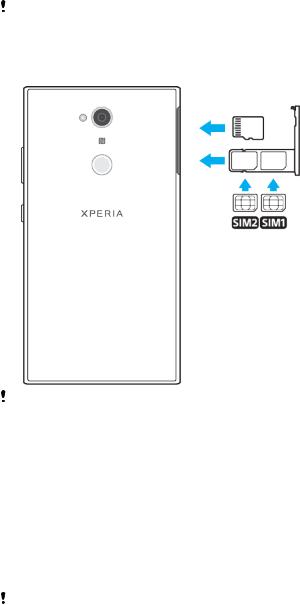
Dual SIM devices are not available in all markets or from all operators.
For information on how to check if your device is Single SIM or Dual SIM, see
Finding the IMEI number(s) of your device on page 15.
To prevent data loss, make sure you turn off your device or unmount the memory card before you drag out the holder to remove the nano SIM card (or cards) or memory card from the device.
To insert the nano SIM cards and the memory card
Do not cut your SIM card, as this may damage your device.
1Drag out the SIM card tray.
2Insert the memory card in the correct orientation into the memory card slot, as shown in the illustration.
3Place the main SIM card (SIM1) securely in the SIM card tray, as shown in the illustration.
4Place the second SIM card (SIM2) securely in the SIM card tray, as shown in the illustration.
5Gently push the tray back into the slot until it fits into place.
Screen protection
Before using your device, remove all protection films to enable full functionality.
Screen covers and protectors may help you protect your device against damage. We recommend you use only those screen covers intended for your Xperia device. The use of third party screen protection accessories may prevent your device from working correctly by covering sensors, lenses, speakers, or microphones and can invalidate the warranty.
Starting your device for the first time
It is recommended that you charge the battery for at least 30 minutes before starting up your device for the first time. You can still use your device while it is charging, see Charging your device on page 35.
The first time you start your device, a setup guide helps you to configure basic settings, personalise your device and sign in to your accounts, for example a Google™ account.
9
This is an internet version of this publication. © Print only for private use.

When you buy your device, a basic screen swipe lock is already set. This means that you have to swipe left or upwards on the screen to unlock it. You can change the security settings later and add other kinds of screen locks.
To turn on the device
Make sure to use the provided USB Type-C cable when charging your device. It is recommended to charge the battery for at least 30 minutes before you turn on the device for the first time.
1 |
Press and hold down the power key |
until the device vibrates. |
2 |
Enter your SIM card PIN when requested, then tap . |
|
3 |
Wait a moment for the device to start. |
|
|
Your SIM card PIN is initially supplied by your network operator, but you can change it later |
|
|
from the Settings menu. |
|
|
To turn o• the device |
|
1 |
Press and hold down the power key |
until the options menu opens. |
2 |
In the options menu, tap Power o•. |
|
It may take a while for the device to shut down.
Why do I need a Google account?
Your Xperia device from Sony runs on the Android platform developed by Google. A range of Google applications and services is available on your device when you purchase it, for example, Gmail™, Google Maps™, YouTube™ and the Play Store™. To get the most out of these services, you need a Google account. For example, a Google account enables you to do the following:
•Download and install applications from Google Play™.
•Synchronise your email, contacts and calendar using Gmail.
•Chat with friends using the Duo™ application.
•Synchronise your browsing history and bookmarks using the Google Chrome™ web browser.
•Identify yourself as the authorised user after a software repair using Xperia Companion.
•Remotely find, lock or clear a lost or stolen device using the Find my device services.
For more information about Android and Google, go to http://support.google.com.
It is crucial to remember your Google account user name and password, since in some situations, you may need it to identify yourself for security reasons. If you fail to give your Google user name and password in such situations, your device is locked. Also, if you have more than one Google account, make sure to enter the details for the relevant account.
To set up a Google account on your device
1 Find and tap Settings > Users > Add user then tap OK.
2 Follow the registration wizard to add a new user. Tap on to access the settings for the New user and the Guest account. You can also share your call and SMS history.
You can also create a Google account using the setup guide when you first start your device, or go online later and create an account at https://myaccount.google.com/.
10
This is an internet version of this publication. © Print only for private use.

To remove a Google account
1 Find and tap Settings > Users.
2 Tap to select which user you want to remove. 3 Tap Remove user, then tap delete.
If you remove your Google account, any security features that are linked to your Google account will no longer be available.
11
This is an internet version of this publication. © Print only for private use.

Device security
Making sure your device is protected
Your device includes security options, strongly recommended in case of loss or theft.
When using a security option to protect your device, it is crucial to remember the details provided at set up.
Screen lock
Set a secure screen lock on your device using a PIN, password, pattern or fingerprint to prevent others from using your device without permission. Once the screen lock is set, it is not possible to unlock the screen or erase the content via a Factory Data Reset without providing the screen lock information.
If you add your contact information on the screen lock, for example your email, this information can be used to get your device back if you lose it.
Google account
Add a Google account so that you can use the Find my device service. In some situations, you may also need to identify yourself for security reasons using your Google account.
Find my device
Use the Find my device service to remotely locate, lock, unlock or erase the content on a lost device. After you have signed in to your Google account, Find my device is turned on by default.
SIM card lock
Lock your SIM cards with a PIN to protect your subscription against misuse. The PIN is required every time you restart your device.
IMEI number
Keep a copy of the IMEI number. If your device is stolen, some network providers can use this number to stop the device from accessing the network in your country or region.
Dual SIM devices have two IMEI numbers.
Backup
Back up the content on your device in case your device is damaged, lost or stolen. See Backing up and restoring content on page 42.
Screen lock
When the screen is locked you have to unlock it with a swipe gesture or with your personal pattern, PIN, password or fingerprint. Initially, the unprotected screen swipe is set, but it is recommended to use a more secure screen lock to protect your device.
The security level of each lock type is listed below in order of weakest to strongest:
•Swipe: no protection, but you have quick access to the Home screen.
•Pattern: draw a simple pattern with your finger to unlock your device.
•PIN: enter a numeric PIN of at least four digits to unlock your device.
•Password: enter an alpha-numeric password to unlock your device.
•Fingerprint: place your registered finger on the sensor to unlock your device.
12
This is an internet version of this publication. © Print only for private use.

Fingerprints need to be registered with Fingerprint Manager before use. To configure the notifications on the lock screen, see Notifications on page 28.
To create or change a screen lock
It is very important that you remember your screen lock when using a pattern, PIN or password. If you forget this information, it may not be possible to restore important data such as contacts and messages. See troubleshooting tips for your device at http://support.sonymobile.com.
1Find and tap Settings > Lock screen & security > Screen lock.
2If requested, confirm your current screen lock.
3Choose an option and follow the on-screen instructions.
4When a secure screen lock is used, you can set the power button to lock the screen, set the screen lock activation time and create a lock screen message by pressing  .
.
If you use a Microsoft Exchange ActiveSync (EAS) account, the EAS security settings may limit the lock screen type to only a PIN or password. Contact your network administrator to check the implemented network security policies.
Unlocking your device automatically
The Smart Lock feature lets you set your device to unlock automatically in certain situations, for example, when connected to a Bluetooth device or carrying it with you.
The Smart Lock feature is available in most markets, countries or regions.
Go to http://www.support.google.com/ and search “smart lock” for more information about the Smart Lock feature.
To enable Smart Lock
1Set a pattern, PIN or password as a screen lock if you have not already done so.
2Find and tap Settings > Lock screen & security > Trust agents.
3Tap the Smart Lock (Google) slider to enable the function.
4 Tap .
5Find and tap Smart Lock.
6Enter your pattern, PIN or password. You need to enter these credentials to change your Smart Lock settings.
7Select a Smart Lock type.
Fingerprint Manager
Register your fingerprint to use it as an additional security method for unlocking your device or authenticating purchases. You can register up to 5 fingerprints on your device.
The pattern, PIN or password screen lock serves as a backup unlock method when a fingerprint is used as a screen lock. Before registering your fingerprint, make sure the sensor is clean and without any visible moisture.
To register a fingerprint for the first time
1Find and tap Settings > Lock screen & security > Fingerprint Manager.
2Tap NEXT. If prompted confirm your pattern, PIN or password, or select your backup screen lock method and follow the on-screen instructions to set it up.
3Tap NEXT and follow the on-screen instructions to complete fingerprint registration.
13
This is an internet version of this publication. © Print only for private use.

To register additional fingerprints
1Find and tap Settings > Lock screen & security > Fingerprint Manager.
2Confirm your pattern, PIN or password.
3Tap  , then follow the on-screen instructions.
, then follow the on-screen instructions.
To delete a registered fingerprint
1Find and tap Settings > Lock screen & security > Fingerprint Manager.
2Confirm your pattern, PIN or password.
3Tap the registered fingerprint, then tap DELETE > DELETE.
To rename a registered fingerprint
1Find and tap Settings > Lock screen & security > Fingerprint Manager.
2Select a registered fingerprint in the list, then enter a name and tap OK.
SIM card protection
You can lock and unlock each SIM card that you use in your device with a PIN. When a SIM card is locked, the subscription linked to the card is protected against misuse, meaning that you have to enter a PIN every time you start your device.
If you enter the PIN incorrectly too many times, your SIM card will get blocked. You then need to enter your PUK (Personal Unblocking Key) and a new PIN. Your PIN and PUK are supplied by your network operator.
To set up a SIM card lock
1Find and tap Settings > Lock screen & security > Set up SIM card lock.
2Dual SIM users, select a SIM card.
3Tap the slider beside Lock SIM card to enable.
4Enter the SIM card PIN and tap OK. The SIM card lock is now active and you will be prompted to enter your PIN every time you restart your device.
To change the SIM card PIN
1Find and tap Settings > Lock screen & security > Set up SIM card lock.
2Dual SIM users, select a SIM card.
3Tap Change SIM PIN.
4Enter the old SIM card PIN and tap OK.
5Enter the new SIM card PIN and tap OK.
6Re-type the new SIM card PIN and tap OK.
|
To unlock a blocked SIM card using the PUK code |
1 |
Enter the PUK code and tap . |
2 |
Enter a new PIN code and tap . |
3 |
Re-enter the new PIN code and tap . |
|
If you enter an incorrect PUK code too many times, you need to contact your network |
|
operator to get a new SIM card. |
Using multiple SIM cards
This function only applies for Dual SIM devices.
Dual SIM devices work with either one or two SIM cards inserted. You can get incoming communication to both SIM cards and select which number to place outgoing communication from. Before using multiple SIM cards, you need to enable them and select a SIM card which will handle data traffic.
You can forward calls that come in on SIM 1 to SIM 2 when SIM 1 is unreachable, and vice versa. This function is called Dual SIM reachability. You must enable it manually. See Forwarding calls on page 68.
14
This is an internet version of this publication. © Print only for private use.
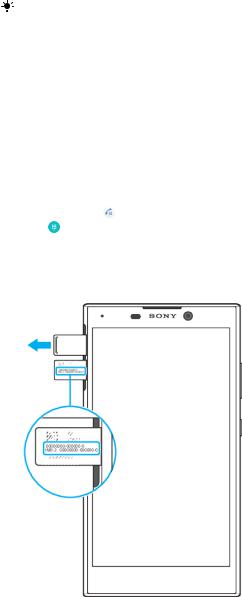
To enable or disable the use of two SIM cards
1Find and tap Settings > Dual SIM.
2Tap the SIM1 and SIM2 sliders to enable or disable the SIM cards.
To rename a SIM card
1Find and tap Settings > Dual SIM.
2Select a SIM card and enter a new name for it.
3Tap OK.
To select which SIM card handles data traffic
1Find and tap Settings > Dual SIM > Mobile data.
2Select the SIM card you want to use for data traffic.
For higher data speeds, select the SIM card that supports the fastest mobile network, for example, LTE.
|
Finding the IMEI number(s) of your device |
|
Your device has one or two unique identification numbers that are referred to as |
|
IMEI or Product ID. You should keep a copy of this. You may require it if your device |
|
is stolen or when contacting support. |
|
Dual SIM devices only: Your device has two IMEI numbers, one for each SIM card |
|
slot. |
|
To view your IMEI number(s) using the dialpad |
1 |
Find and tap . |
2 |
Tap . |
3Enter *#06# into the dialpad. The IMEI number(s) are displayed automatically.
To view your IMEI number(s) on the label strip
1Drag out the SIM/Memory card tray.
2Drag the strip outwards using your fingernail. The strip displays the IMEI number(s).
15
This is an internet version of this publication. © Print only for private use.

Finding, locking or erasing a lost device
Google offers a location and security web service called Find my device. After you have signed in to a Google account, Find my device is turned on by default. If you lose your device, you can use Find my device to:
•Find and show where your device is located on a map.
•Lock your device and present a message on the lock screen.
•Unlock your device and reset it by erasing its content.
•Activate the ringer, even if the sound is turned off.
Your device must be turned on, have an internet connection and have the location service activated. The Find my device service may not be available in all countries or regions.
For additional information about Find my device, go to https://www.support.google.com/ and search for “Find my device”.
If you erased the content on your device using Find my device, you must enter the username and password for a Google account in order to use your device again. This can be any Google account which you have set up on your device as an owner. If you can’t give this information during the setup, you won’t be able to use your device at all after a reset.
To verify that your device can be found
•Go to https://www.google.com/android/find and sign in using your Google account.
Using location services
Location services allow applications such as Maps and the camera to use information from your mobile or Wi-Fi network as well as Global Positioning System (GPS) information to determine your approximate location. If you're not within a clear line of sight to GPS satellites, your device can determine your location using the Wi-Fi function. And if you're not within range of a network, your device can determine your location using your mobile network.
In order to use your device to find out where you are, you need to enable location services.
You may incur data connection charges when you connect to the internet from your device.
To enable or disable location services
•Find and tap Settings > Google > Location. Tap the slider to enable or disable location services.
To enable or disable Google Location Sharing
1Find and tap Settings > Google > Location.
2Tap Google Location Sharing > .
3Select the time span you want to have the function turned on and choose an option to select the contact you want to share your location with. You can also choose the way to share your location by tapping More.
You can also keep track of your location history under Google Location History.
Improving GPS accuracy
The first time you use the GPS function in your device, it can take a few minutes for your location to be found. To help the search, make sure not to cover the GPS antenna, as highlighted in the image. GPS signals can pass through clouds and plastic, but not through most solid objects such as buildings and mountains. If your location isn't found after a few minutes, move to another location.
16
This is an internet version of this publication. © Print only for private use.

17
This is an internet version of this publication. © Print only for private use.

Learning the basics
Using the touchscreen
Tapping
•Open or select an item.
•Mark or unmark a checkbox or option.
•Enter text using the on-screen keyboard.
Touching and holding
•Move an item.
18
This is an internet version of this publication. © Print only for private use.

•Activate an item-specific menu.
•Activate selection mode, for example, to select several items from a list.
Pinching in and out
•Pinch in and out on web pages, photos and maps, and when you’re taking photos or shooting videos.
Swiping
•Scroll up or down a list.
•Scroll left or right, for example, between Home screen panes.
•Swipe left or right to reveal more options.
19
This is an internet version of this publication. © Print only for private use.
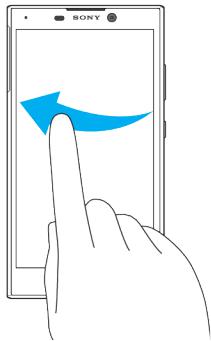
Flicking
•Scroll quickly, for example, in a list or on a web page. You can stop the scrolling movement by tapping the screen.
Turning the screen on or off
When your device is on and left idle for a set period of time, the screen dims and turns off to save battery power. You can change how long your screen stays active before it turns off.
When your screen is turned off, your device can be locked or unlocked, depending on your screen lock setting. See Screen lock on page 12.
To turn the screen on or o•
•Briefly press the power key  .
.
To adjust the idle time before the screen turns o•
1Find and tap Settings > Display > Sleep.
2Select an option.
Smart backlight control
The smart backlight control keeps the screen on as long as the device is held in your hand. Once you put down the device, the screen turns off according to your sleep setting.
To enable or disable the Smart backlight control function
1Find and tap Settings > Display > Smart backlight control.
2Tap the slider to enable or disable the function.
Home screen
The Home screen is the starting point for using your device. It's similar to the desktop on a computer screen. The number of Home screen panes is represented by a series of dots at the lower part of the Home screen. The highlighted dot shows the pane that is currently displayed.
20
This is an internet version of this publication. © Print only for private use.
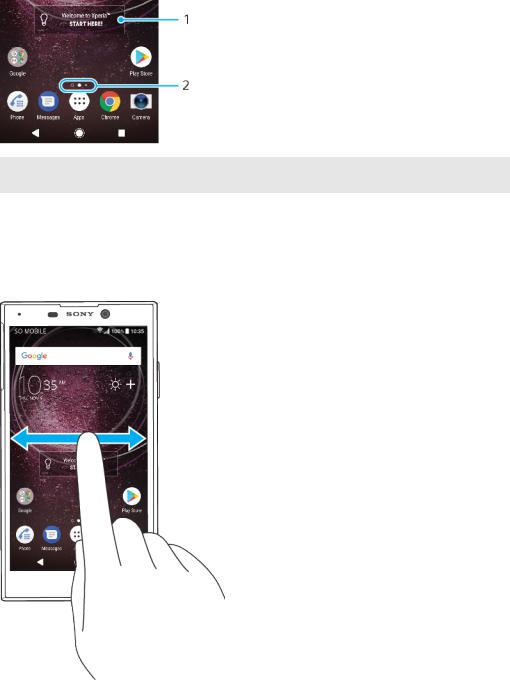
Home screen overview
1Welcome to Xperia widget — Tap to open the widget and select a task such as copying content from your old device or setting up Xperia services
2Dots — Represents the number of Home screen panes
To go to the Home screen
•Press  .
.
To browse the Home screen
Home screen panes
You can delete panes or add new ones to your Home screen (up to a maximum of twenty panes).
21
This is an internet version of this publication. © Print only for private use.

To set a pane as the main Home screen pane
1Touch and hold an empty area on your Home screen until the device vibrates.
2Flick left or right to browse to the pane that you want to set as your main Home screen pane, then tap  .
.
When Google Feed is enabled, the left-most pane is reserved for this service and the main Home screen pane cannot be changed. For more information, see Google Feed on
page 100.
To add a pane to your Home screen
1Touch and hold an empty area on your Home screen until the device vibrates.
2To browse the panes, flick all the way to the right or left, then tap  .
.
When Google Feed is enabled, the left-most pane is reserved for this service and additional panes cannot be added to the left. For more information, see Google Feed on page 100.
To delete a pane from your Home screen
1Touch and hold an empty area on your Home screen until the device vibrates.
2Flick left or right to browse to the pane that you want to delete, then tap on the top right corner of the pane.
Home screen settings
To disable or uninstall an application from the Home screen
Disabling a pre-installed app deletes all data, but the app can be enabled again from Settings > Apps. Only downloaded apps can be fully uninstalled.
1Touch and hold the application you want to disable or uninstall.
2All applications that can be disabled or uninstalled are indicated by .
3Tap the relevant application, then tap Disable if the app came pre-installed on your device or OK if the app was downloaded and you would like to uninstall it.
|
To adjust the size of icons on your Home screen |
1 |
Touch and hold an empty area on your Home screen until the device |
|
vibrates, then tap . |
2 |
Tap Icon size, then select an option. |
|
22 |
This is an internet version of this publication. © Print only for private use.
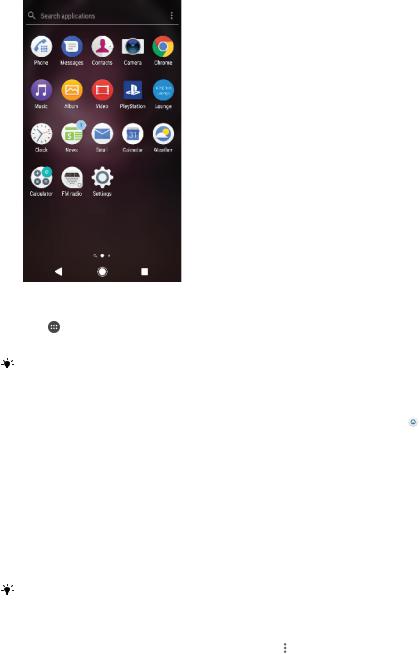
Application screen
The Application screen, which you open from the Home screen, contains the applications that come pre-installed on your device as well as applications that you download.
|
To view all applications on the Application screen |
1 |
Tap . |
2 |
Flick left or right on the Application screen. |
|
You can also search for recently viewed apps by swiping left from the Application screen. |
|
To enable or disable the recommended apps listings |
1 |
Touch and hold an empty area on your Home screen, then tap . |
2 |
Tap the App recommendations slider. |
To open an application from the Application screen
•When the Application screen is open, flick left or right to find the application, and then tap the application.
To search for an application from the Application screen
1When the Application screen is open, tap Search applications.
2Enter the name of the application that you want to search for.
You can also search for applications by swiping down or right from the Application screen.
To arrange applications on the Application screen 1 When the Application screen is open, tap .
2Tap Sort apps, then select an option.
To add an application shortcut to the Home screen
1On the Application screen, touch and hold an application icon until the device vibrates, then drag the icon to the top of the screen. The Home screen opens.
2Drag the icon to the desired location on the Home screen, then release your finger.
23
This is an internet version of this publication. © Print only for private use.
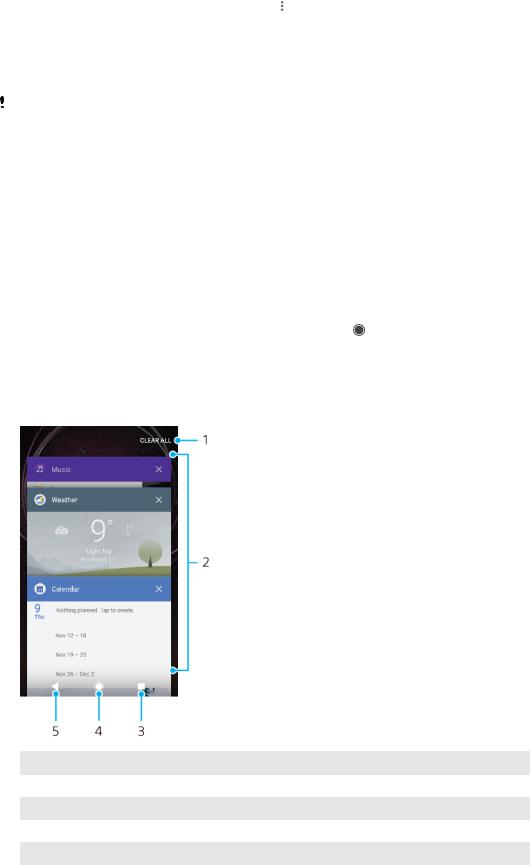
To move an application on the Application screen 1 When the Application screen is open, tap .
2Make sure that Own order is selected under Sort apps.
3Touch and hold the application until the device vibrates, then drag it to the new location.
To disable or uninstall an application from the Application screen
Whether an app can be uninstalled or disabled depends on the app, and if it was preinstalled on your device or downloaded. Downloaded apps can be uninstalled. Pre-installed apps cannot be uninstalled, only disabled if the app supports this. If you disable a preinstalled app, you can enable it again under Settings > Apps.
1Touch and hold the application you want to uninstall or disable.
2Tap  > DISABLE to disable an app, or OK to uninstall it.
> DISABLE to disable an app, or OK to uninstall it.
Navigating applications
You can navigate between applications using the navigation keys and the recently used applications window, which lets you switch easily between all recently used applications. The navigation keys are the Back key, the Home key, and the Recent apps key. You can also pop open two applications on the screen at once using the split screen mode, if the application supports multi-window function. Some applications get closed when you press the Home key to exit while others are paused or continue to run in the background. If an application is paused or running in the background, you can continue where you left off the next time you open the application.
Navigating applications overview
1Clear all – Close all the recently used applications
2Recently used applications window – Open a recently used application
3Recent apps key – Open the recently used applications window and the favourites bar
4Home key – Exit an application and go back to the Home screen
5Back key – Go back to the previous screen within an application or close the application
To open the recently used applications window
•Press  .
.
24
This is an internet version of this publication. © Print only for private use.
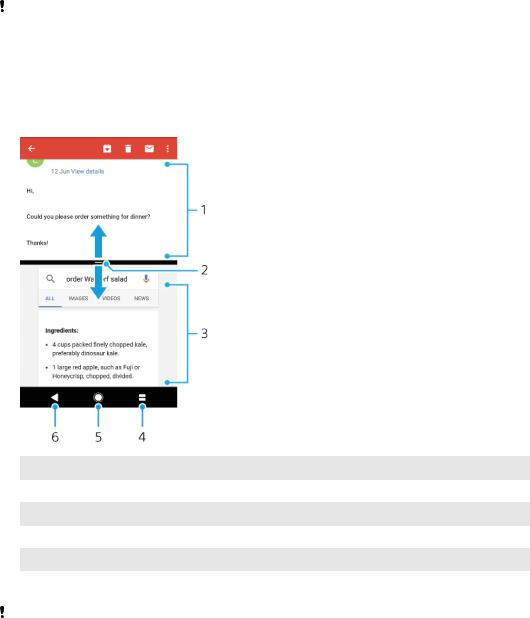
To quickly switch between recently used applications
•Quickly press  twice.
twice.
To close all the recently used applications
•Press  and then tap CLEAR ALL.
and then tap CLEAR ALL.
To open a menu in an application
•While using an application, tap  or
or  .
.
A menu is not available in all applications.
Split screen mode
Split screen mode enables you to view two applications at once, for example, if you want to view your email inbox and a web browser at the same time.
Split screen overview
1Application 1
2Split screen border – Drag to resize windows
3Application 2
4Split screen key – Select a recently used application
5Home key – Go back to the Home screen
6Back key – Go back to the previous screen within an application or close the application
Not all applications support split screen mode.
25
This is an internet version of this publication. © Print only for private use.

To use split screen mode
1Make sure that the two applications that you want to use in split screen mode are open and running in the background.
2Open the application that you would like to use in split screen mode, then
tap and hold . The application will be assigned to the first part of the split screen.
3Select the second desired application from the thumbnail list.
4If you want to resize the split screen windows, drag the split screen border in the centre.
5 To exit split screen mode, tap and hold while the split screen windows are displayed.
|
One-handed operations |
|
You can activate the one-handed operation mode to use your device with one |
|
hand. |
|
To enable or disable one-handed operations |
1 |
From your Home screen, tap > Settings > One-handed operations. |
2 |
Tap the Resize screen slider to enable or disable the function. |
3 |
Tap , then drag your thumb from the right corner to the center of the |
|
screen. |
Tap the Optimised apps slider to customize the options for One-handed operations.
To adjust the position of the screen
1 To move the screen to the left side or to the right side, tap or accordingly.
2To move the screen upwards or downwards, drag the horizontal stripes.
3To resize the screen, drag the three diagonal stripes.
To return to using the full screen, tap  .
.
Widgets
Widgets are small applications that you can use directly on your Home screen. They also function as shortcuts. For example, the Weather widget allows you to see basic weather information directly on your Home screen. When you tap the widget, the full Weather application opens. You can download additional widgets from Google Play.
To add a widget to the Home screen
1Touch and hold any empty area on your Home screen until the customisation menu appears, then tap Widgets.
2Find and tap the widget that you want to add.
To resize a widget
1Touch and hold a widget until the device vibrates, then release it.
2If the widget can be resized, the Resize option appears. For example, the Calendar widget is one that can be resized.
3Tap Resize and drag the dots to shrink or expand the widget.
4To confirm the new size, tap anywhere on the Home screen.
To move a widget
•Touch and hold the widget until the device vibrates, then drag it to the new location.
To remove a widget
•Touch and hold the widget until the device vibrates, then drag it to Remove from home screen.
26
This is an internet version of this publication. © Print only for private use.
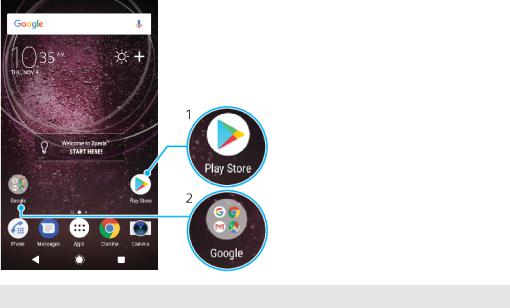
Shortcuts and folders
Use shortcuts and folders to manage your applications and keep your Home screen tidy.
Shortcuts and folders overview
1Access an application using a shortcut
2Access a folder containing applications
To add an application shortcut to your Home screen
1Touch and hold an empty area on your Home screen until the device vibrates.
2In the customisation menu, tap Widgets > Shortcuts.
3Scroll through the list and select an application. The selected application gets added to the Home screen.
To move an item on the Home screen
•Touch and hold the item until the device vibrates, then drag the item to the new location.
To remove an item from the Home screen
•Touch and hold the item until the device vibrates, then drag the item to
Remove from home screen on the top of the screen.
To create a folder on the Home screen
•Touch and hold an application icon or a shortcut until the device vibrates, then drag and drop it on top of another application icon or shortcut.
To add items to a folder on the Home screen
•Touch and hold an item until the device vibrates, then drag the item to the folder.
To rename a folder on the Home screen
1Tap the folder to open it.
2Tap the folder's title bar to show the Folder name field.
3Enter the new folder name and tap DONE.
27
This is an internet version of this publication. © Print only for private use.

Background and themes
Your device comes with a default background, but you can adapt the Home screen and lock screen to your own style using wallpapers and themes featuring different colours and patterns.
A wallpaper may be used without changing any of the other elements of your Home screen and lock screen.
Themes can include a wallpaper, a screensaver, title bars, and a sound scheme that all fit together to create a unique look and feel for your device.
To change your wallpaper
1Tap Settings > Wallpaper > Xperia Home.
2Select a wallpaper and tap Apply. Select an option.
You can also use a photo as your wallpaper. Instead of selecting a wallpaper from the option shown, tap Photos or Album. Choose a photo and tap Set wallpaper.
To set a theme
1Touch and hold an empty area on your Home screen until the device vibrates.
2Tap Themes.
3Choose an option:
•To use an existing theme, select the theme, then tap APPLY THEME.
•To download a new theme, tap GET MORE THEMES.
When you change a theme, the background also changes in some applications.
|
Taking a screenshot |
|
You can capture still images of any screen on your device as a screenshot. |
|
Screenshots you take are automatically saved in the Album application. |
|
To take a screenshot |
1 |
Long press the power key until a prompt window appears. |
2 |
Tap . |
You can also take a screenshot by pressing and holding the power key and volume down key at the same time.
To view your screenshot
1Double-tap the status bar to display the Notification panel.
2Tap the screenshot.
Notifications
Notifications inform you of events such as new messages and calendar notifications as well as activities in progress such as file downloads. Notifications appear in the following places:
•The status bar
•The notification panel
•The lock screen
•The app icon
28
This is an internet version of this publication. © Print only for private use.

To open or close the Notification panel
1To open the Notification panel, drag the status bar downwards, or simply double-tap it.
2To close the Notification panel, drag or flick the panel upwards.
After opening the Notification panel, you can access the Quick settings panel by dragging the status bar down again.
To take action on a notification in the Notification panel
•Tap the notification.
You can directly reply to chat or email messages in the Notification panel.
To dismiss a notification from the Notification panel
•Swipe the notification left or right.
Not all notifications can be dismissed.
To change settings for notifications, simply drag the notification slowly to the left or right, then tap  .
.
To expand a notification on the Notification panel
•Drag the notification downwards to expand and view more information about the notification without opening the app.
Not all notifications are expandable.
To clear all notifications from the Notification panel
•Tap CLEAR ALL.
If there is a long list of notifications, scroll down to find the CLEAR ALL button.
To take action on a notification from the lock screen
•Double-tap the notification.
29
This is an internet version of this publication. © Print only for private use.

To dismiss a notification from the lock screen
•Swipe the notification left or right.
To expand a notification on the lock screen
•Drag the notification downwards.
Not all notifications are expandable.
Notification display options on the lock screen
Show all notification Get all notifications on the lock screen. When you have this setting turned content on, all content (including the content of incoming emails and chat
messages) will be visible on your lock screen.
Don't show notifications You won't get any notifications on the lock screen. at all
To select the notifications to display on the lock screen
1 Find and tap Settings > Notifications.
2 Tap , and then tap On the lock screen.
3 Select an option.
You can keep notifications on the lock screen until you swipe to dismiss them. To enable this feature, tap the Keep notifications on lock screen slider.
Setting the notification level for an app
Block all |
Block all notifications from the selected app. |
Sounds and vibrations o• Block sound and screen notifications.
Interrupts in Priority only Receive notifications from this app even when Do not disturb is set to Priority only.
You can set notification channels to categorise notification levels. Long press a notification to change the notification categories.
To set the notification level for an app
1Find and tap Settings > Notifications.
2Select the desired app.
3Tap the sliders to adjust notification settings as desired.
Notification light
The notification light informs you about battery status and some other events. For example, a flashing white light means there is a new message or a missed call. The notification light is enabled by default but can be disabled manually.
|
When the notification light is disabled, it only lights up when there is a battery status |
|
warning, for example, when the battery level goes below 15 percent. |
|
To enable or disable the notification light |
1 |
Find and tap Settings > Notifications > . |
2 |
Tap the slider beside Notification light to enable or disable the function. |
30
This is an internet version of this publication. © Print only for private use.
